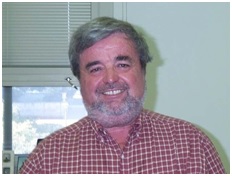Oregon CAS/EPS & SMTA Oregon - The Corrosion of Copper-Implications for Electronic Circuitry
IEEE Oregon Joint CPMT/CAS Chapter
(in cooperation with SMTA, IMAPS, IPC & EMA)
Topic: The Corrosion of Copper-Implications for Electronic Circuitry
Speaker: Digby D. Macdonald, University of California at Berkeley
Date: Thursday, October 26th, 2017, 6.00–8.00pm
(Rescheduled from May 18)
Location: PCC Willow Creek Center, Room 313
241 SW Edgeway Drive (near SW 185th and Baseline Road) Beaverton, OR 97006
(seminar room sponsored by the PSU ECE department)
Directions: http://www.pcc.edu/about/locations/willow-creek/
Date and Time
Location
Hosts
Registration
-
 Add Event to Calendar
Add Event to Calendar
- 241 SW Edgeway Drive
- Beaverton, Oregon
- United States 97006
- Building: PCC Willow Creek Center
- Room Number: 313
- Click here for Map
- Contact Event Host
-
Jim Morris
- Co-sponsored by SMTA, IMAPS & EMA
- Starts 09 September 2017 07:00 PM UTC
- Ends 26 October 2017 07:00 PM UTC
- No Admission Charge
- Menu: pizza
Speakers
 Digby Macdonald of UC Berkeley
Digby Macdonald of UC Berkeley
The Corrosion of Copper-Implications for Electronic Circuitry
Copper is used extensively in electronic circuitry for interconnects, because of its chemical stability and high electrical conductivity. However, copper is also susceptible to thermodynamic activation in the presence of trace amounts of certain compounds in the atmosphere, primarily (but not limited to) sulfur compounds, such as hydrogen sulfide and organic polysulfides. These compounds give rise to oxidation reactions that occur at very low electrochemical potentials, such that hydrogen evolution from condensed water on the metal surface produces a viable cathodic process, resulting in rapid corrosion. In this seminar, I will summarize a great deal of fundamental work that has been carried out to define the mechanism of the corrosion of copper and relate it to the corrosion of copper interconnects in electronic circuitry. I will discuss the phenomenon of passivity in terms of the Point Defect Model (PDM) that has been developed by the author over the past 30 years and which has enjoyed no conflict with experiment when confluence between theory and experiment has been assured. In particular, I will explore the growth and breakdown of passive oxide and sulfide films that lead to both general and localized corrosion and I will discuss strategies for inhibiting the corrosion processes with attention being paid to the use of vapor-phase inhibitors in electronic circuitry.
Biography:
Born in Thames, New Zealand, December 7 1943, Professor Macdonald gained his BSc and MSc degrees in Chemistry at the University of Auckland, New Zealand, and his Ph.D. degree in Chemistry from the University of Calgary in Canada. He has served as Assistant Research Officer at Atomic Energy of Canada Ltd., Lecturer in Chemistry at Victoria University of Wellington, New Zealand, Senior Research Associate at Alberta Sulfur Research, Honorary Associate Professor at the Chemistry Department of the University of Calgary, Director and Professor of the Fontana Corrosion Center, Ohio State University, Vice President, Physical Sciences Division, SRI International, Menlo Park, California and Professor and later Distinguished Professor of Materials Science and Engineering at Pennsylvania State University from 1991 to the end of 2012.
Professor Macdonald has received numerous awards and honors, including the 1991 Carl Wagner Memorial Award from The Electrochemical Society; the 1992 Willis Rodney Whitney Award from The National Association of Corrosion Engineers for “contributions to the science of corrosion”; the W. B. Lewis Memorial Lecture from Atomic Energy of Canada, ltd., for his “contributions to the development of nuclear power in the service of mankind”; the H. H. Uhlig Award from The Electrochemical Society; the U. R. Evans Award from The Institute of Corrosion, UK; the 20th Khwarizmi International Award in fundamental science; and the Wilson Research and Teaching Awards of the Pennsylvania State University.
He is an elected fellow of NACE-International; The Electrochemical Society; the Royal Society of Canada; the Royal Society of New Zealand; ASM International; the World Innovation Foundation; the Institute of Corrosion (UK); and the International Society of Electrochemistry. From 1993 to 1997 he was a member of the US Air Force Science Advisory Board with the protocol rank of Lieutenant General. He was awarded the US Air Force Medal for Meritorious Civilian Service in 1997. Dr. Macdonald was a Trustee of ASM International and has recently been inducted Doctuer Honoris Causa by INSA-Lyon, Lyon, France. Among other awards, he was the 2010 recipient of the Lee Hsun Research Award of the Chinese Academy of Sciences; the recipient of the 2013 Gibbs Award from the International Association on the Properties of Water and Steam; was the 2014 recipient of the Frumkin Medal from the International Society of Electrochemistry, and received the 2015 Palladium Medal from the Electrochemical Society. In 2016 he received the Ad Augusta Award from the Auckland Grammar School.
Dr. Macdonald has published about 1000 papers in peer-reviewed scientific journals, books, and conference proceedings, plus four books, one of which ("Transient Techniques in Electrochemistry") established an important area of electrochemical research, and has 10 patents and numerous invention disclosures credited to his name. His professional competence lies in the fields of electrochemistry, corrosion science, battery science and technology, thermodynamics, chemical kinetics, high temperature aqueous chemistry, nuclear power technology, energy conversion technology, and physical chemistry.
Finally, under his tutelage, more than 150 students have graduated with advanced degrees in Chemistry and Materials Science and Engineering over the past four decades. Of particular importance is that Dr. Macdonald is the originator of the modern theory of passivity in the form of the Point Defect Model and has been a pioneer of Electrochemical Impedance Spectroscopy, particularly for corrosion reaction mechanistic analysis.
Address:UC Berkeley, , California, United States
Agenda
6:00pm Refreshments and social
6:30pm Presentation
7:30pm Questions and Discussion

